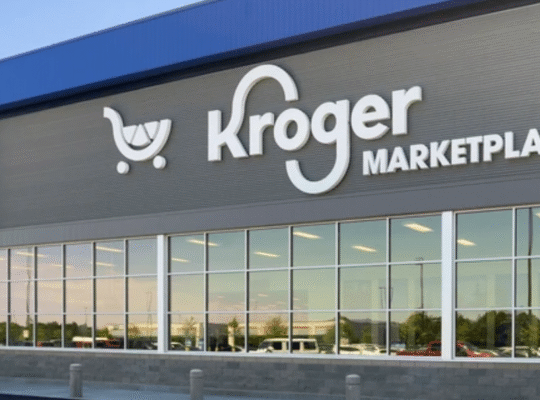Introduction
Kroger, one of the most critical grocery store chains within the United States, has lately introduced a chain of surprising store closures, which have sent shockwaves through various communities. The decisions to shut down pickup places have had sizeable ripple effects, not handiest for hundreds of personnel but also for the neighborhoods that rely upon those shops day-to-day necessities. With a legacy spanning over a century, Kroger has been more than just a place to shop for groceries; it has functioned as a network hub, corporation, and monetary anchor. Therefore, the surprising closures have prompted substantial trouble, prompting reactions from people, residents, and community leaders alike. This weblog delves deep into the motives behind the closures, the responses from affected humans, and what it way for the destiny of grocery retail in America.
The Scope and Impact of Kroger’s Store Closures
Kroger’s latest closures no longer accompany a single geographical sample. Stores in both city and suburban settings had been impacted, regularly with confined previous caution. On a few times, personnel had been given surely weeks to prepare for their final shifts. These shutdowns are not isolated but part of a broader corporate method that includes streamlining operations and putting in place those deemed underperforming. The cause supplied by Kroger consists of growing operational costs, changing customer behaviors, and competitive pressures within the grocery sector.
The human toll is good-sized. Employees, many of whom have labored for Kroger for years or even for a long time, have all at once found themselves without jobs. This abrupt transition has created stress and uncertainty for workers who now face the undertaking of finding new employment in a turbulent, tough work marketplace. Additionally, corporations have lost an important beneficial aid, especially in low-profit areas in which Kroger stores often function the maximum capacity and are a cheap choice for sparkling meals and critical family gadgets.
Employee Reactions and Struggles
For Kroger personnel, the closures represent more than in reality the lack of a paycheck. Workers have voiced feelings of betrayal and unhappiness, especially whilst closures are introduced with little observe. Many personnel have invested years into the organisation, developing relationships with colleagues and customers alike. The suddenness of the layoffs has raised questions about the agency’s commitment to its employees.
Some personnel were offered the possibility to switch to exclusive locations, but this isn’t always a viable alternative. Transportation barriers, caregiving duties, and confined vacancies at nearby stores often make relocation no longer viable. As a result, many personnel are left and no longer have the usage of desire to start over, often without severance or a sufficient unemployment resource.
In unionized shops, difficult work groups have stepped in to demand higher protections for their members. They argue that personnel deserve more than handiest a final paycheck—they deserve transparency, recognition, and help with reemployment. The closures have reignited debates over the rights of humans and the duties of big companies during intervals of downsizing.
Community Backlash and Social Implications
Local businesses have moreover voiced robust reactions to Kroger’s closures. For many residents, the store is more than a place to shop—it’s a community fixture. The absence of a close-by grocery store might also have a ways-accomplishing consequences, especially in neighborhoods that already battle with constrained access to clean food. These closures risk growing or exacerbating food deserts, in which citizens must journey lengthy distances to find cheap groceries.
City officials and community activists have organized protests and public conferences to voice their troubles. In some regions, petitions were circulated worrying that Kroger reconsider its picks or at least provide an extra obvious method. Community individuals worry that the closures will result in expanded unemployment, reduced asset values, and a significant decline in community splendid of life.
Economic and Strategic Drivers Behind the Closures
While feelings run immoderate amongst those at once affected, Kroger has stated practical commercial employer motives for its alternatives. The grocery company has been present process big adjustments, driven with the resource of technological advancements, changing consumer behavior, and increasing competition from online and discount stores. Companies like Amazon and Walmart have redefined what customers expect from grocery buying, with same-day delivery and massive online services becoming the new norm.
Kroger has been investing closely in its digital systems and logistical infrastructure. By ultimately underperforming shops, the organization hopes to redirect resources in the direction of extra worthwhile ventures, which include e-commerce and strategic partnerships. In Kroger’s view, the one decision is important for lengthy-time period sustainability and competitiveness in a unexpectedly evolving market.
However, critics argue that the closures can also backfire by the usage of alienating dependable clients and terrible the logo’s community-oriented image. They contend that while digital transformation is important, it ought not come at the fee of Kroger’s foundational role in serving neighborhood neighborhoods.
Case Studies: Cities Most Affected
Several towns have borne the brunt of Kroger’s closures more than others. In Los Angeles, more than one place has shut down, including a few in lower-earnings regions in which citizens now face huge challenges gaining access to groceries. Similarly, in cities like Memphis and Houston, closures have disrupted community lifestyles and left masses unemployed.
These closures have prompted community governments to search for opportunity answers. In a few cases, city officials have reached out to other grocery chains to fill the void. Others have considered public-non-public partnerships to ensure persisted get right of access to food in underserved regions. Yet, these efforts frequently take time and require sizeable investment, leaving corporations in a lurch during the period in between.
The Broader Industry Trend
Kroger isn’t always by itself in its selection to shut stores. Across the retail sector, companies are reevaluating their bodily footprints. The upward thrust of online shopping, inflationary pressures, and labor shortages are leading many to rethink how and where they perform. The pandemic accelerated plenty of these traits, pushing customers to adopt virtual shopping behavior at high-quality expenses.
This shift has created a paradox. While customers price convenience and innovation, further, they palso rice network-based retail. Balancing these competing demands is one of the largest annoying conditions going on in cutting-edge grocery chains. Kroger’s closures highlight the anxiety between company performance and community responsibility—a tension that is probably to persist for decades.
Future Prospects for Affected Employees and Communities
For employees, locating new possibilities will depend closely on neighborhood exertions, marketplace situations, and the supply of comparable roles. Workforce development applications and retraining initiatives ought to play an important role in helping displaced workers transition to new industries. Some network colleges and nonprofit companies have already stepped in to assist.
Communities, however, must grapple with the instant fallout while also planning for the future. Local governments may additionally need to put money into transportation, food distribution packages, and financial revitalization efforts to mitigate the damage. Civic engagement could be key, as citizens recommend the resources and regulations they want to rebuild.
Kroger’s Response and Public Relations Efforts
In reaction to the grievance, Kroger has released statements emphasizing the hassle of the selections and the organization’s long-term strategic goals. They have expressed appreciation for their employees and cited steps to help with challenge placement and benefits continuation in which are viable. However, many critics continue to be skeptical, viewing those efforts as too little, too late.
The organization has also released community tasks in specific areas, perhaps in an attempt to balance the horrific publicity. These consist of food donation programs, aid for neighborhood nonprofits, and investments in academic projects. While those efforts are commendable, they may not absolutely atone for the tangible loss skilled by affected neighborhoods.
Impact on Communities
Food Access and “Food Deserts”
In rural and underserved urban regions, losing a Kroger can notably decrease get entry to to fresh produce, healthy products, and less expensive staples. Fast Company notes that more than 18 million Americans live in low‑earnings, low‑get proper of entry to zones, in which the closest grocery store is either farther than a mile away in city settings or over 10 miles in rural regions.
When those shops are near, groups can be compelled to depend upon convenience stores, fast food, or restricted stacked grocery choices, heightening problems related to nutrition, health effects, and chronic illness.
Local Economic Ripple Effect
Beyond food, Aroger’s savings enable dozens of neighborhood jobs and generate foot traffic that blesses close-by small businesses. Chambers of commerce in cities like Abingdon and Gassaway warned that losing Kroger might also want to stall economic momentum and discourage destination funding.
Community Backlash and Mobilization
In Metro Atlanta, customers in Brookhaven, Decatur, and Atlanta voiced unhappiness and frustration at the imminent closures. While a few neighborhoods had alt options like Aldi, City Market, and Latin‑meals shops, others, mainly condominium-dense areas, were concerned approximately comfort, transportation, and rising living costs.
One lady on Morosgo Way said she “can’t believe” the store is very last given its constant clients to wait, at the same time as some elderly person was concerned about relying on her son for rides as soon as it shuts.
What Can Be Done Differently?
Moving ahead, there are numerous instructions that each Kroger and different shops can study from this episode. Transparency is paramount—employees and groups deserve sincere communication and good enough be aware earlier than crucial changes earlier. Companies should moreover discover extra collaborative methods to preserve closures, involving close by leaders and stakeholders in decision-making procedures.
Additionally, reinvestment in affected corporations can go a long way towards rebuilding trust. This may additionally need to encompass supporting community meal banks, funding small business improvement, or supporting efforts to attract other shops to fill the gap. Strategic closures may be inevitable in a converting financial machine; however, they don’t need to leave devastation in their wake.
Conclusion
The sudden closure of Kroger shops has revealed deep fault lines inside the relationship between huge organizations and the communities they serve. While Kroger pursues strategic realignment in the face of economic pressures, the fallout for employees and neighborhoods is actual and at once. These closures are more than simply corporate decisions—they are events that reshape lives and redefine the social material of communities. As America’s retail landscape continues to change, the need for added empathetic and inclusive strategies in company decision-making has by no means diminished.
Frequently Asked Questions (FAQs)
Q1: Why is Kroger closing such a lot of stores?
A: Kroger has cited several motives for the closures, which consist of growing operational fees, changing consumer habits, advanced opposition, and the need for awareness of greater worthwhile ventures like e-trade and logistics. The company views the closures as part of a strategic plan to stay aggressive in a changing retail environment.
Q2: How are employees suffering from these shutdowns?
A: Employees are experiencing venture loss, economic instability, and emotional pressure because of the unexpected nature of the closures. While some can be supplied with transfers, many are left without feasible alternatives and are seeking new employment, regularly without sufficient help or severance.
Q3: What is the impact on neighborhood groups?
A: The closures are developing meal deserts, specifically in low-income neighborhoods, and are fundamental to elevated unemployment. Many groups are dropping an important useful resource and are involved approximately the long-term economic and social results.
Q4: What moves are close-by governments taking?
A: In response to the closures, a few local governments try to attract extraordinary grocery chains, offer emergency food assistance, or create monetary development plans to revitalize affected areas. However, those measures regularly require full-time and resources.
Q5: How has Kroger responded to the backlash?
A: Kroger has issued public statements acknowledging the trouble of the choices and has mentioned constrained aid measures for affected personnel. They have additionally highlighted ongoing community resource efforts in special regions; however, many view these responses as insufficient.
Q6: What can be done to guide affected humans and citizens?
A: Support can encompass activity training, unemployment benefits, mental fitness offerings, and transportation help. Long-term answers require coordinated efforts from the government, nonprofits, and the private sector to rebuild financial stability in affected regions.
Q7: Is this a sign of broader tendencies inside the grocery enterprise?
A: Yes, Kroger’s closures are part of a far wider trend stimulated by way of technological trade, online shopping, and the financial pressures facing conventional retail. Other chains are also reassessing their footprints and shifting to a more of extra virtual-centric approach.
Q8: What instructions can extraordinary agencies have a look at from this?
A: The significance of transparency, employee guide, and network engagement can not be overstated. Companies need to strive to balance strategic goals with social obligations to maintain consideration and goodwill for the duration of transitions.
Disclaimer
Created with the Synergy of AI innovation and through research, this article is intended to offer clear, accurate, and actionable insights. Each point has been double-checked to ensure it adds genuine value to your knowledge base. Our mission is to guide you with reliable, easy-to-understand information. Enjoy your reading experience and continue exploring new ideas!






